Page 3 of 560
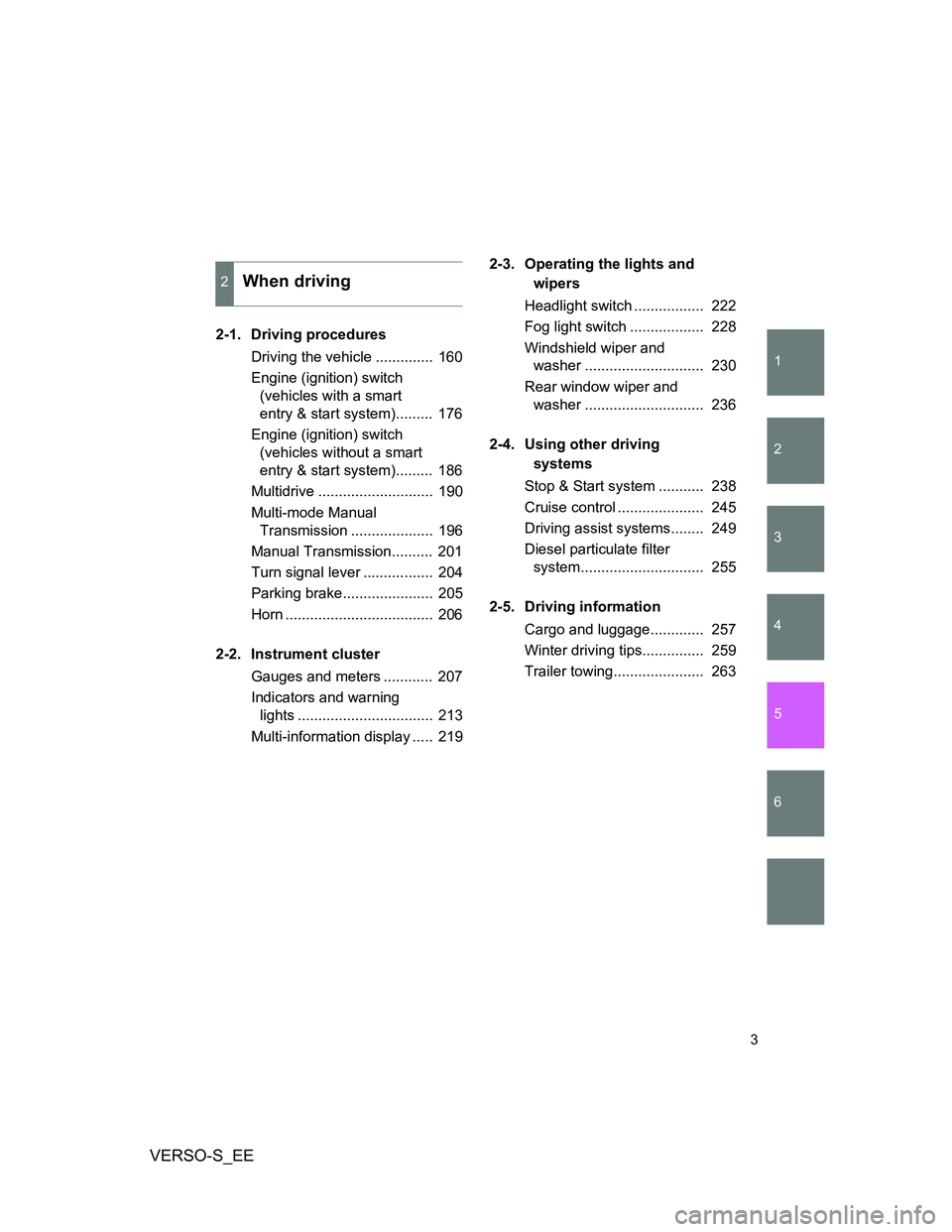
1
2
3
4
5
6
VERSO-S_EE
3
2-1. Driving procedures
Driving the vehicle .............. 160
Engine (ignition) switch
(vehicles with a smart
entry & start system)......... 176
Engine (ignition) switch
(vehicles without a smart
entry & start system)......... 186
Multidrive ............................ 190
Multi-mode Manual
Transmission .................... 196
Manual Transmission.......... 201
Turn signal lever ................. 204
Parking brake...................... 205
Horn .................................... 206
2-2. Instrument cluster
Gauges and meters ............ 207
Indicators and warning
lights ................................. 213
Multi-information display ..... 2192-3. Operating the lights and
wipers
Headlight switch ................. 222
Fog light switch .................. 228
Windshield wiper and
washer ............................. 230
Rear window wiper and
washer ............................. 236
2-4. Using other driving
systems
Stop & Start system ........... 238
Cruise control ..................... 245
Driving assist systems........ 249
Diesel particulate filter
system.............................. 255
2-5. Driving information
Cargo and luggage............. 257
Winter driving tips............... 259
Trailer towing...................... 263
2When driving
Page 159 of 560
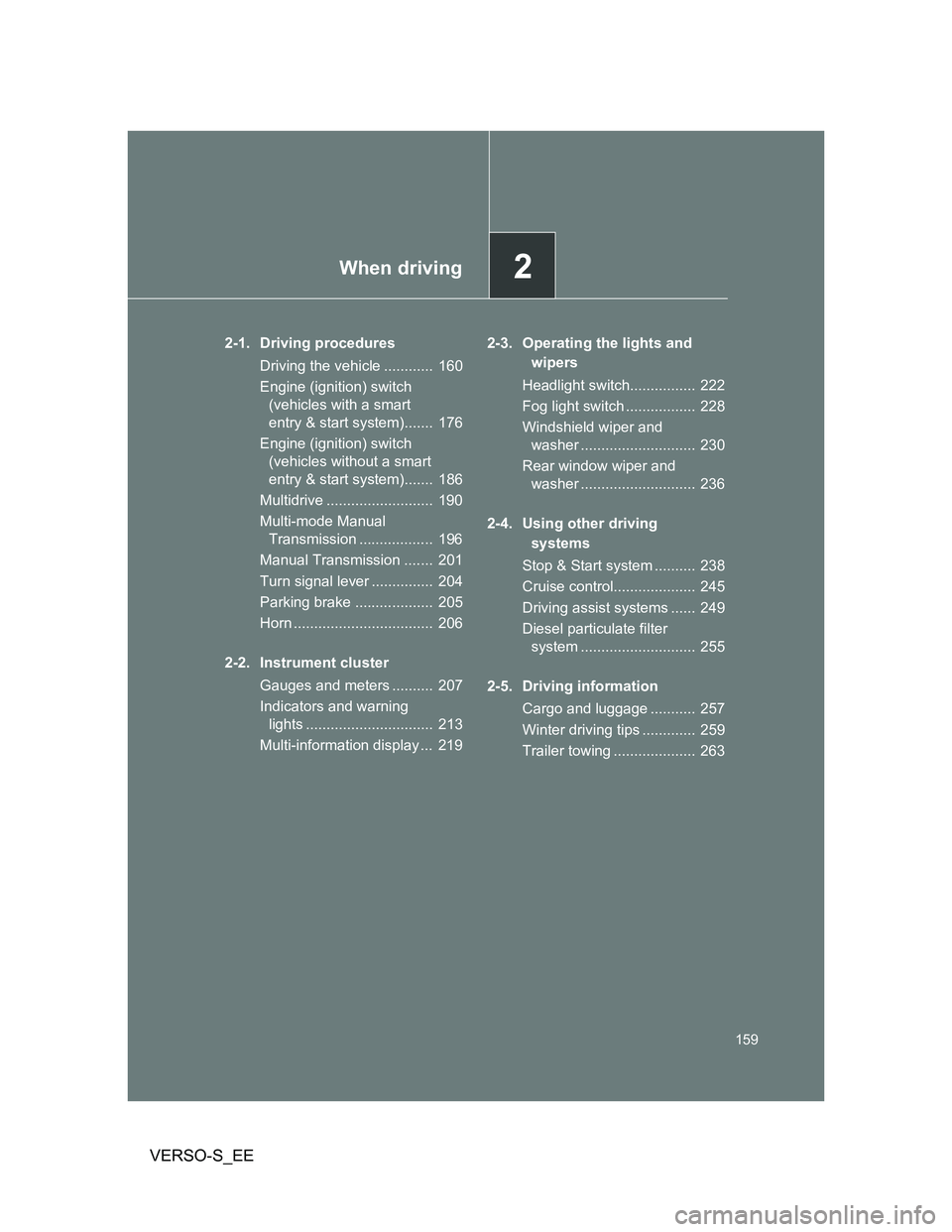
2When driving
159
VERSO-S_EE
2-1. Driving procedures
Driving the vehicle ............ 160
Engine (ignition) switch
(vehicles with a smart
entry & start system)....... 176
Engine (ignition) switch
(vehicles without a smart
entry & start system)....... 186
Multidrive .......................... 190
Multi-mode Manual
Transmission .................. 196
Manual Transmission ....... 201
Turn signal lever ............... 204
Parking brake ................... 205
Horn .................................. 206
2-2. Instrument cluster
Gauges and meters .......... 207
Indicators and warning
lights ............................... 213
Multi-information display ... 2192-3. Operating the lights and
wipers
Headlight switch................ 222
Fog light switch ................. 228
Windshield wiper and
washer ............................ 230
Rear window wiper and
washer ............................ 236
2-4. Using other driving
systems
Stop & Start system .......... 238
Cruise control.................... 245
Driving assist systems ...... 249
Diesel particulate filter
system ............................ 255
2-5. Driving information
Cargo and luggage ........... 257
Winter driving tips ............. 259
Trailer towing .................... 263
Page 165 of 560
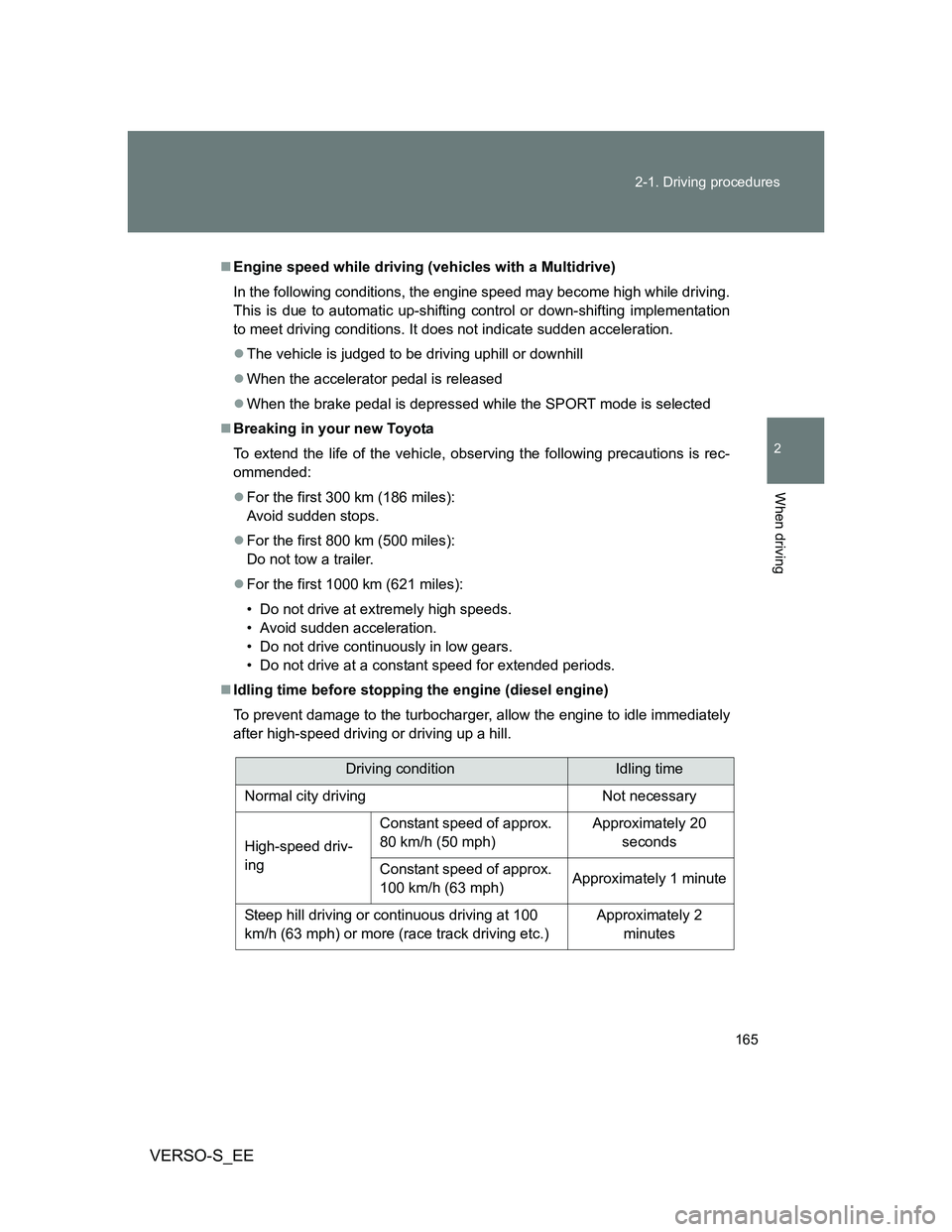
165 2-1. Driving procedures
2
When driving
VERSO-S_EE
Engine speed while driving (vehicles with a Multidrive)
In the following conditions, the engine speed may become high while driving.
This is due to automatic up-shifting control or down-shifting implementation
to meet driving conditions. It does not indicate sudden acceleration.
The vehicle is judged to be driving uphill or downhill
When the accelerator pedal is released
When the brake pedal is depressed while the SPORT mode is selected
Breaking in your new Toyota
To extend the life of the vehicle, observing the following precautions is rec-
ommended:
For the first 300 km (186 miles):
Avoid sudden stops.
For the first 800 km (500 miles):
Do not tow a trailer.
For the first 1000 km (621 miles):
• Do not drive at extremely high speeds.
• Avoid sudden acceleration.
• Do not drive continuously in low gears.
• Do not drive at a constant speed for extended periods.
Idling time before stopping the engine (diesel engine)
To prevent damage to the turbocharger, allow the engine to idle immediately
after high-speed driving or driving up a hill.
Driving conditionIdling time
Normal city driving Not necessary
High-speed driv-
ingConstant speed of approx.
80 km/h (50 mph)Approximately 20
seconds
Constant speed of approx.
100 km/h (63 mph)Approximately 1 minute
Steep hill driving or continuous driving at 100
km/h (63 mph) or more (race track driving etc.)Approximately 2
minutes
Page 248 of 560
248 2-4. Using other driving systems
VERSO-S_EE
CAUTION
To avoid operating the cruise control by mistake
Switch the cruise control off using the “ON-OFF” button when not in use.
Situations unsuitable for cruise control
Do not use cruise control in any of the following situations.
Doing so may result in loss of control and could cause an accident resulting
in death or serious injury.
In heavy traffic
On roads with sharp bends
On winding roads
On slippery roads, such as those covered with rain, ice or snow
On steep hills
Vehicle speed may exceed the set speed when driving down a steep hill.
When your vehicle is towing a trailer or during emergency towing
Page 263 of 560
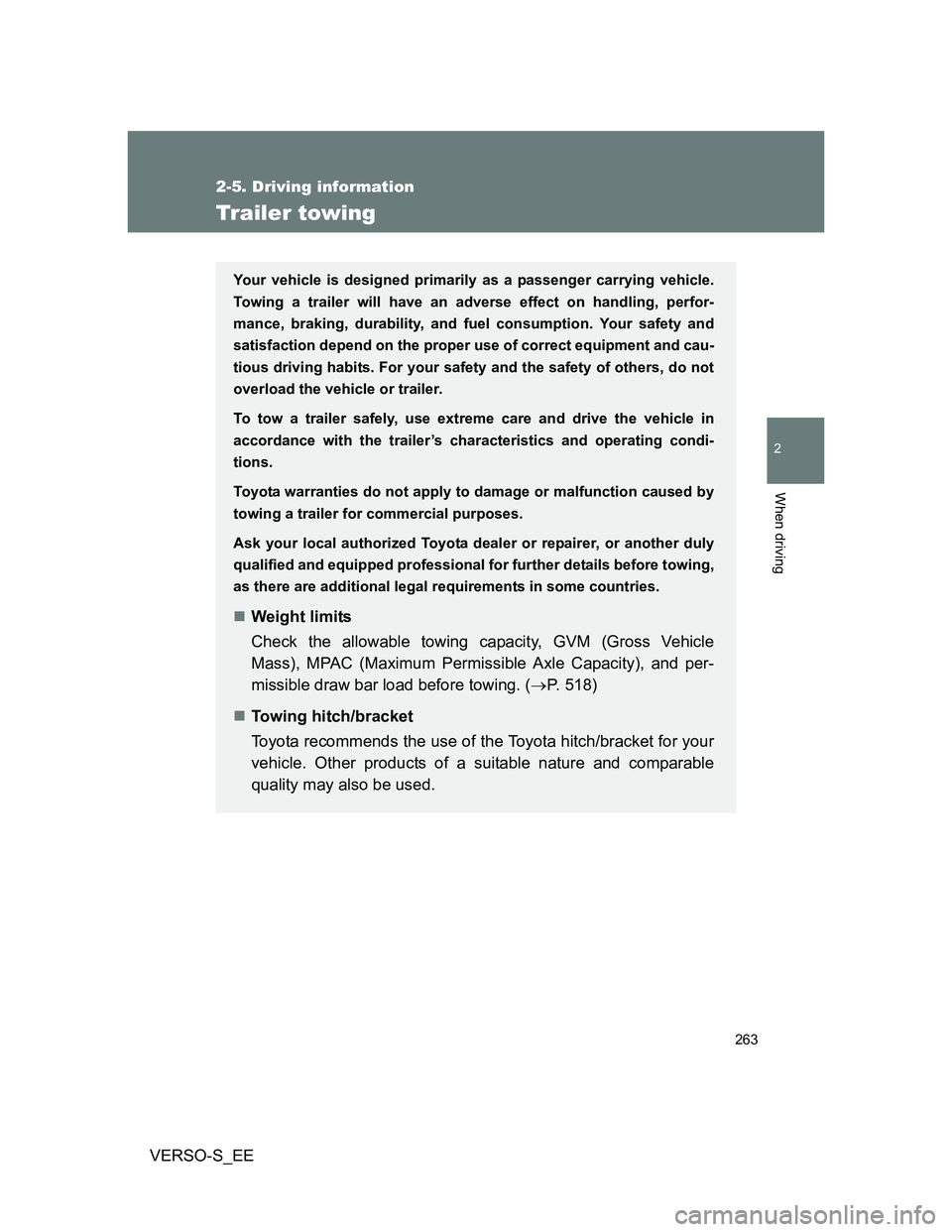
263
2-5. Driving information
2
When driving
VERSO-S_EE
Trailer towing
Your vehicle is designed primarily as a passenger carrying vehicle.
Towing a trailer will have an adverse effect on handling, perfor-
mance, braking, durability, and fuel consumption. Your safety and
satisfaction depend on the proper use of correct equipment and cau-
tious driving habits. For your safety and the safety of others, do not
overload the vehicle or trailer.
To tow a trailer safely, use extreme care and drive the vehicle in
accordance with the trailer’s characteristics and operating condi-
tions.
Toyota warranties do not apply to damage or malfunction caused by
towing a trailer for commercial purposes.
Ask your local authorized Toyota dealer or repairer, or another duly
qualified and equipped professional for further details before towing,
as there are additional legal requirements in some countries.
Weight limits
Check the allowable towing capacity, GVM (Gross Vehicle
Mass), MPAC (Maximum Permissible Axle Capacity), and per-
missible draw bar load before towing. (P. 518)
Towing hitch/bracket
Toyota recommends the use of the Toyota hitch/bracket for your
vehicle. Other products of a suitable nature and comparable
quality may also be used.
Page 264 of 560
264 2-5. Driving information
VERSO-S_EE
Important points regarding trailer loads
Total trailer weight and permissible drawbar load
Total trailer weight
Weight of the trailer itself plus the
trailer load should be within the
maximum towing capacity.
Exceeding this weight is danger-
ous.
(P. 518)
When towing a trailer, use a fric-
tion coupler or friction stabilizer
(sway control device).
Permissible drawbar load
Allocate the trailer load so that
the drawbar load is greater than
25 kg (55.1 lb.) or 4% of the tow-
ing capacity. Do not let the draw-
bar load exceed the indicated
weight. (P. 518)
Page 266 of 560
266 2-5. Driving information
VERSO-S_EE
CAUTION
When the gross vehicle mass limit or maximum permissible axle
capacity is exceeded
Do not exceed the established speed limit for towing a trailer in built-up
areas or 100 km/h (62 mph), whichever is the lower.
Failing to observe this precaution may lead to an accident causing death or
serious injury.
Page 268 of 560
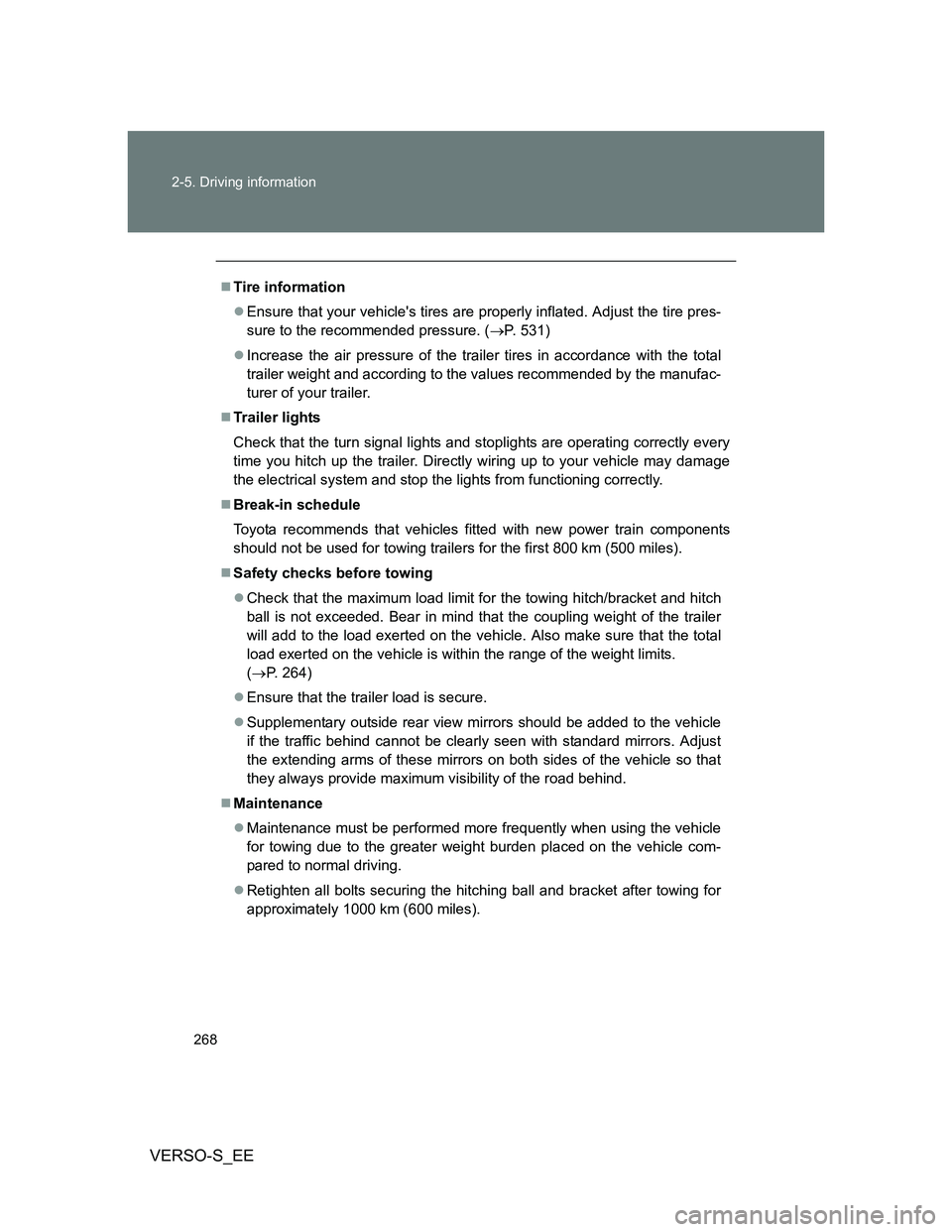
268 2-5. Driving information
VERSO-S_EE
Tire information
Ensure that your vehicle's tires are properly inflated. Adjust the tire pres-
sure to the recommended pressure. (P. 531)
Increase the air pressure of the trailer tires in accordance with the total
trailer weight and according to the values recommended by the manufac-
turer of your trailer.
Trailer lights
Check that the turn signal lights and stoplights are operating correctly every
time you hitch up the trailer. Directly wiring up to your vehicle may damage
the electrical system and stop the lights from functioning correctly.
Break-in schedule
Toyota recommends that vehicles fitted with new power train components
should not be used for towing trailers for the first 800 km (500 miles).
Safety checks before towing
Check that the maximum load limit for the towing hitch/bracket and hitch
ball is not exceeded. Bear in mind that the coupling weight of the trailer
will add to the load exerted on the vehicle. Also make sure that the total
load exerted on the vehicle is within the range of the weight limits.
(P. 264)
Ensure that the trailer load is secure.
Supplementary outside rear view mirrors should be added to the vehicle
if the traffic behind cannot be clearly seen with standard mirrors. Adjust
the extending arms of these mirrors on both sides of the vehicle so that
they always provide maximum visibility of the road behind.
Maintenance
Maintenance must be performed more frequently when using the vehicle
for towing due to the greater weight burden placed on the vehicle com-
pared to normal driving.
Retighten all bolts securing the hitching ball and bracket after towing for
approximately 1000 km (600 miles).